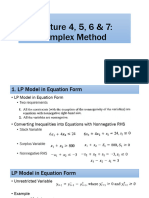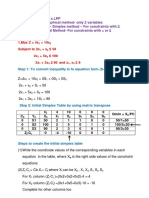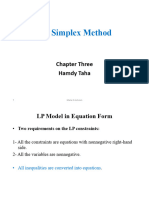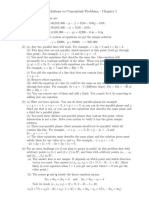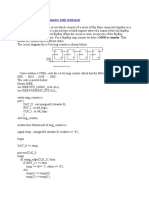Introduction To Simplex Method: Module - 1 Lecture Notes - 5 Linear Programming Problems-III
Introduction To Simplex Method: Module - 1 Lecture Notes - 5 Linear Programming Problems-III
Uploaded by
raj ranjanCopyright:
Available Formats
Introduction To Simplex Method: Module - 1 Lecture Notes - 5 Linear Programming Problems-III
Introduction To Simplex Method: Module - 1 Lecture Notes - 5 Linear Programming Problems-III
Uploaded by
raj ranjanOriginal Description:
Original Title
Copyright
Available Formats
Share this document
Did you find this document useful?
Is this content inappropriate?
Copyright:
Available Formats
Introduction To Simplex Method: Module - 1 Lecture Notes - 5 Linear Programming Problems-III
Introduction To Simplex Method: Module - 1 Lecture Notes - 5 Linear Programming Problems-III
Uploaded by
raj ranjanCopyright:
Available Formats
Optimization Techniques in Civil Engineering
Module – 1 Lecture Notes – 5
Linear Programming Problems-III
Introduction to Simplex Method
Example
Maximize Z = 5x1 +4x2
Subject to 6x1 + 4x2 ≤ 24
x1 + 2x2 ≤ 6
-x1 + x2 ≤ 1
x2 ≤ 2
x1, x2 ≥ 0
Rewrite problem as
Maximize Z - 5x1 - 4x2 = 0
Subject to
6x1 + 4x2 + S1 = 24
x1 + 2x2 + 0S1 + S2 = 6
-x1 + x2 + 0S1 + 0S2 + S3 = 1
0x1 + x2 + 0S1 + 0S2 + 0S3 + S4 = 2
Rewrite the objective function as
Z - 5x1 + 4x2 + 0S1 +0S2 +0S3 + 0S4 = 0
Where S1, S2, S3, S4 → Stack variables
Solution
STARTING SIMPLEX TABLEAU
Basic Z x1 x2 S1 S2 S3 S4 Solution
Z 1 -5 -4 0 0 0 0 0
S1 0 6 4 1 0 0 0 24
S2 0 1 2 0 1 0 0 6
S3 0 -1 1 0 0 1 0 1
S4 0 0 1 0 0 0 1 2
Non basic (zero) variables – (x1, x2)
Basic variables (S1, S2, S3, S4)
Step - Substitute the non-basic variables
(x1, x2) = (0, 0)
Dr. Baboo Rai | National Institute of Technology Patna
Optimization Techniques in Civil Engineering
- Note the special 0-1 arrangement of the coefficients of Z and basic variables (S1, S2, S3, S4)
Check the rate of improvement –
Value of Z will increase by 4 for each unit increase in x2 i.e. rate of improvement for Z is 5 for
x1 and 4 for x2 So, x1 variable is selected as entering variable
Or
It is the variable with most +ve coefficient in Objective function Z = 5x1 + 4x2 or it is the most
-ve coefficient when simplex method redefines the objective function as Z - 5x1 - 4x2 = 0
The above Rule is Known as Optimality Condition.
Step - Compute the non-negative ratios of the RHS of the equations (or in solution column)
Basic x1 Solution Ratio or Intercept
S1 6 24 x1 = 24/6 = 4 (Minimum)
S2 1 6 x1 = 6/1 = 6
S3 -1 1 x1 = 1/-1 = -1 (Ignore)
S4 0 2 x1 = 2/0 = ∞ (Ignore)
The minimum non negative ratio automatically identifies the current based variable S1 as the
leaving variable and assigns x1 = 4. Check graph for Explanation
Entering variable column is called Pivot column AND Leaving variable row is called Pivot
row AND The intersection of pivot column and pivot row is called pivot element.
Basic Z x1 x2 S1 S2 S3 S4 Solution
Z 1 -5 -4 0 0 0 0 0
S1 0 6 4 1 0 0 0 24
S2 0 1 2 0 1 0 0 6
S3 0 -1 1 0 0 1 0 1
S4 0 0 1 0 0 0 1 2
The swapping process – Simplex Tableau 2
Non basic (zero) variable (S1, x2)
Basic variable (x1, S2, S3, S4)
The Swapping process is based on GAUSS JORDAN ROW OPERATIONS
The Gauss Jordan computations needed to produce the new basic solution include two types
Dr. Baboo Rai | National Institute of Technology Patna
Optimization Techniques in Civil Engineering
1. Pivot row-
(a) Replace the leaving variable in basic column with entering variable (i.e. replace
x1 with S1 column)
(b) New pivot row = Current pivot row ÷ Pivot Element (x1 = S1/6)
2. New row = (Current row) – (Its pivot column coefficient × New pivot row)
New x1 row = (Current S1 row)/6
= 1/6 × [0, 6, 4, 1, 0, 0, 0, 24] = [0, 1, 2/3, 1/6, 0, 0, 0, 4]
New Z row = (Current Z row) – (–5) × New x1 row
= [1, –5, –4, 0, 0, 0, 0, 0] – (–5) × [0, 1, 2/3, 1/6, 0, 0, 0, 4] = [1, 0, -2/3, 5/6, 0, 0, 0, 20]
New S2 row = Current S2 row – (1) × New x1 row
= [0, 1, 2, 0, 1, 0, 0, 6] – (1) × [0, 1, 2/3, 1/6, 0, 0, 0, 4] = [0, 0, 4/3, -1/6, 1, 0, 0, 2]
New S3 row = Current S3 row – (-1) × (New x1 row)
= [0, -1, 1, 0, 0, 1, 0, 1] – (-1) × [0, 1, 2/3, 1/6, 0, 0, 0, 4] = [0, 0, 5/3, 1/6, 0, 1, 0, 5]
New S4 row = Current S4 row – (0) × (New x1 row) = Current S4 row
Simplex Tableau 2
Basic Z x1 x2 S1 S2 S3 S4 Solution
Z 1 0 -2/3 5/6 0 0 0 20
x1 0 1 2/3 1/6 0 0 0 4
S2 0 0 4/3 -1/6 1 0 0 2
S3 0 0 5/3 1/6 0 1 0 5
S4 0 0 1 0 0 0 1 2
Basic Solution x1 = 4, S2 = 2, S3 = 5, S4 = 2 and Z = 20
Again check - optimality condition.
Z + 0x1 – (2/3) x2 + (5/6) S1 = 0
Entering variable = x2 (most -ve coefficient)
Check the Leaving variable
Basic X2 Solution Ratio or Intercept
S1 2/3 4 x2 = 4 ÷ (2/3) = 6
S2 4/3 2 x2 = 2 ÷ (4/3) = 1.5 (Minimum)
S3 5/3 5 x2 = 5 ÷ (5/3) = 3
S4 1 2 x2 = 2 ÷ 1 = 2
Dr. Baboo Rai | National Institute of Technology Patna
Optimization Techniques in Civil Engineering
Minimum non negative ratio i.e. 1.5 identifies (4/3) as the pivot value & as the leaving variable.
Repeat Gauss-Jordan row operations
New pivot row = Current S2 row ÷ (4/3) = [0, 0, 4/3, -1/6, 1, 0, 0, 2] × (3/4)
= [0, 0, 1, -1/8, 3/4, 0, 0, 3/2]
New Z-row = (current z-row) – (-2/3) × (New x2 row)
= [1, 0, -2/3, 5/6, 0, 0, 0, 2, 0] – (-2/3) × [0, 0, 1, -1/8, 3/4, 0, 0, 3/2]
= [1, 0, 0, 3/4, 1/2, 0, 0, 21]
New x1 row = (Current x1 row) – (2/3) × (New x2 row)
= [0, 1, 2/3, 1/6, 0, 0, 0, 4] – (2/3) × [0, 0, 1, -1/8, 3/4, 0, 0, 3/2]
= [0,1, 0, 1/4, -1/2, 0, 0, 3]
New S3 row = Current S3 row – (5/3) × (New x2 row)
New S4 row = Current S4 row – (1) × (New x2 row)
Simplex Tableau 3
Basic Z x1 x2 S1 S2 S3 S4 Solution
Z 1 0 0 3/4 1/2 0 0 21
x1 0 1 0 1/4 -1/2 0 0 3
x2 0 0 1 -1/8 3/4 0 0 3/2
S3 0 0 0 3/8 -5/4 1 0 5/2
S4 0 0 0 1/8 -3/4 0 1 1/2
Observation –
Based on optimality condition, none of the Z-row coefficients associated with non-basic
variables S1 & S2 are negative. Hence the last tableau is optional
x1 = 3, x2 = 3/2, S3 = 5/2, S4 = 1/2 & Z = 21
i.e. Z = 5x1 + 4x2 = 5×3 + 4×(3/2) = 21
SUMMARY -
Optimality condition –
(a) In a maximization problem the entering variable is the non-basic variable having
most negative coefficient in the Z-row.
(b) In a minimization problem the entering variable is the non-basic variable having the
most positive coefficients in the Z-row.
Dr. Baboo Rai | National Institute of Technology Patna
Optimization Techniques in Civil Engineering
(c) The optimum is reached at the iterations where all Z-row coefficients of the non-
basic variables are non-negative in case of maximization problem and non-positive
in case minimization problem.
Feasibility condition
(a) For both maximization and minimization problems the leaving variable is the basic
variables associated with the smallest non negative ratio (with strictly positive
denominator).
************************************
Dr. Baboo Rai | National Institute of Technology Patna
You might also like
- E-Ticket 7u5ctsDocument2 pagesE-Ticket 7u5ctsDaneyal MirzaNo ratings yet
- Dynamic Analysis of Structures PDFDocument755 pagesDynamic Analysis of Structures PDFJardeyFrancisVallejo0% (1)
- Essentials of Operations ManagementDocument11 pagesEssentials of Operations ManagementShriya Parmeshwaran50% (2)
- Lesson 1 INTRO ICTDocument22 pagesLesson 1 INTRO ICTPrecious Dhayve Castillos100% (1)
- Column Designs Calculation Excel FileDocument45 pagesColumn Designs Calculation Excel FileFarukNo ratings yet
- Chapter 3 The Simplex Method and Sensitive AnalysisDocument16 pagesChapter 3 The Simplex Method and Sensitive Analysisjanimubarkob23No ratings yet
- L4 5 6 7 SimplexMethodDocument45 pagesL4 5 6 7 SimplexMethodHarsh KumarNo ratings yet
- LP Standard FormDocument8 pagesLP Standard FormfostbarrNo ratings yet
- Simplex Method: Example (All Constraints Are )Document14 pagesSimplex Method: Example (All Constraints Are )PraveenNo ratings yet
- Simplex Method: Minimization Two Phase MethodDocument27 pagesSimplex Method: Minimization Two Phase Methodmelbe5jane5quiamcoNo ratings yet
- The Simplex Method.1Document40 pagesThe Simplex Method.1wajdxothmanNo ratings yet
- CH 03 Simplex Method and Sensitivity AnalysisDocument121 pagesCH 03 Simplex Method and Sensitivity AnalysisAura fairuzNo ratings yet
- Lecture 8 Algebraic SolutionDocument18 pagesLecture 8 Algebraic Solutionayang5355No ratings yet
- Software Engineering: Engineering Department Computer Systems EngineeringDocument23 pagesSoftware Engineering: Engineering Department Computer Systems EngineeringReema AfifiNo ratings yet
- Formulate The LDocument7 pagesFormulate The LsarNo ratings yet
- OR1 Pracetice For Midterm SolutionDocument8 pagesOR1 Pracetice For Midterm Solutionngọc nguyễnNo ratings yet
- Simplex MethodDocument14 pagesSimplex Methodhossheg73No ratings yet
- L09 - Some Exceptional Cases in LPPs PDFDocument30 pagesL09 - Some Exceptional Cases in LPPs PDFNirmitNo ratings yet
- Teori Pengambilan Keputusan Berdasarkan Kondisi PastiDocument11 pagesTeori Pengambilan Keputusan Berdasarkan Kondisi Pastiratna murtiNo ratings yet
- Haramaya University: College of Business and EconomicsDocument48 pagesHaramaya University: College of Business and EconomicsYG DENo ratings yet
- QDM (OR) GSR028622 TewahidoDocument8 pagesQDM (OR) GSR028622 TewahidoTewahedo GeneneNo ratings yet
- Simplex Method ComputationDocument7 pagesSimplex Method ComputationGoody keyzNo ratings yet
- Riset Operasi SimpleksDocument4 pagesRiset Operasi Simpleks07. IdaAyuDesyFranciskaDewi ManajemenNo ratings yet
- Lec 5Document5 pagesLec 5zoro madaraNo ratings yet
- OperacionesDocument14 pagesOperacionesOscar Daniel Moran PiñaNo ratings yet
- The Simplex Method: MAXIMIZATION: Z 2 X X X 10 X X 20 X 5 X, X, X 0Document5 pagesThe Simplex Method: MAXIMIZATION: Z 2 X X X 10 X X 20 X 5 X, X, X 0Princess AmberNo ratings yet
- Chapter3 - LP Algebraic SolutionDocument5 pagesChapter3 - LP Algebraic Solutionabesmit1No ratings yet
- Simplex MethodDocument5 pagesSimplex MethodSAMOIERNo ratings yet
- (1d) Linear Programming - Simplex MethodDocument32 pages(1d) Linear Programming - Simplex MethodDennis NavaNo ratings yet
- Simplex Method Problem-SolvedDocument3 pagesSimplex Method Problem-SolvedChandra Hasan75% (4)
- نموذجDocument17 pagesنموذجreema alafifiNo ratings yet
- Lab 3 OR Operations ResearchDocument15 pagesLab 3 OR Operations Researchbnzayd2005No ratings yet
- Assignment - Nourhan KhaledDocument5 pagesAssignment - Nourhan KhaledNourhan KhaledNo ratings yet
- Chpter 3-Simplex AlgorithmDocument34 pagesChpter 3-Simplex AlgorithmabdullaNo ratings yet
- Problem 1Document17 pagesProblem 1Roqaia AlwanNo ratings yet
- Wacana NihDocument5 pagesWacana NihFadjrirap 13No ratings yet
- System EngineeringDocument8 pagesSystem EngineeringAbhishek KumarNo ratings yet
- 3.3a - Simplex Method (M Method) - Min ObjectiveDocument22 pages3.3a - Simplex Method (M Method) - Min ObjectiveAbdullah NaseemNo ratings yet
- Final Exam - Solution 1Document6 pagesFinal Exam - Solution 1ahmedkahlaoui71No ratings yet
- Linear Programming: Artificial Starting Solution: X X X X X X X X X XDocument4 pagesLinear Programming: Artificial Starting Solution: X X X X X X X X X XHaron Delon CENo ratings yet
- Or1 HW45 Group7Document24 pagesOr1 HW45 Group7Lê Thế KiênNo ratings yet
- Homework Assignment 2 Term - 4: Submitted To Professor Jitamitra Desai PGP 2021-23Document28 pagesHomework Assignment 2 Term - 4: Submitted To Professor Jitamitra Desai PGP 2021-23Param Shah100% (1)
- Correction Tutorial 4 LP Ex 1 2 4 5Document5 pagesCorrection Tutorial 4 LP Ex 1 2 4 5rymachayebNo ratings yet
- Dual Simplex Method For Solving The PrimalDocument49 pagesDual Simplex Method For Solving The PrimalPotnuru VinayNo ratings yet
- American University of Ras Al Khaimah Operations Research (MEPM 531) Midterm Exam - Fall 2020Document14 pagesAmerican University of Ras Al Khaimah Operations Research (MEPM 531) Midterm Exam - Fall 2020Roqaia AlwanNo ratings yet
- Clase 1. Simplex - Hasta Ejercico 3Document11 pagesClase 1. Simplex - Hasta Ejercico 30255537No ratings yet
- Ex 5 Discrete MathDocument2 pagesEx 5 Discrete MathManuel FloresNo ratings yet
- Maximizacion PracticaDocument2 pagesMaximizacion PracticaJose IcNo ratings yet
- 9. Simplex Method (M Technique) - Min Objective CaseDocument22 pages9. Simplex Method (M Technique) - Min Objective Caseah1350057No ratings yet
- Simplex Method in Tabular Form: Construct The Initial Simplex TableauDocument10 pagesSimplex Method in Tabular Form: Construct The Initial Simplex TableauSachin MailareNo ratings yet
- Big-M Method (Introduction) : Artificial VariableDocument10 pagesBig-M Method (Introduction) : Artificial Variablesravanicharitha MamidiNo ratings yet
- Simplex MethodDocument2 pagesSimplex MethodbababababananaNo ratings yet
- Me MF f344 LPP SlidesDocument14 pagesMe MF f344 LPP SlidesSrikar RenikindhiNo ratings yet
- Ca2 orDocument9 pagesCa2 orShreyasri GhoshalNo ratings yet
- bahrain university Ch4 Qm-350Document46 pagesbahrain university Ch4 Qm-350mrmaabs2No ratings yet
- Operations Research 1Document9 pagesOperations Research 1Faisal Saleh RazaNo ratings yet
- BIGM - Two PhaseDocument58 pagesBIGM - Two PhaseSudhanwa KulkarniNo ratings yet
- LP SimplexDocument21 pagesLP SimplexAhmed DiabNo ratings yet
- Chapter 4 2024Document41 pagesChapter 4 2024abdodosskiiNo ratings yet
- Simplex MethodDocument61 pagesSimplex MethodvasudhasinghNo ratings yet
- Math 308 Solutions To Conceptual Problems - Chapter 1Document3 pagesMath 308 Solutions To Conceptual Problems - Chapter 1Mehul JoshiNo ratings yet
- Si PDFDocument1 pageSi PDFStevan RiañoNo ratings yet
- CH 5 Class 3 OR 4 2024Document3 pagesCH 5 Class 3 OR 4 2024ahmed ragehNo ratings yet
- LPP TotalDocument33 pagesLPP TotalJatin ThakkarNo ratings yet
- Optimization Lecture-6 PDFDocument2 pagesOptimization Lecture-6 PDFraj ranjanNo ratings yet
- LP Model in Equation Form: Module - 1 Lecture Notes - 4 Linear Programming Problems-IIDocument3 pagesLP Model in Equation Form: Module - 1 Lecture Notes - 4 Linear Programming Problems-IIraj ranjanNo ratings yet
- Graphical Method: Module - 1 Lecture Notes - 3 Linear Programming Problems-IDocument5 pagesGraphical Method: Module - 1 Lecture Notes - 3 Linear Programming Problems-Iraj ranjanNo ratings yet
- Module - 1 Lecture Notes - 2 Optimization Problem and Model FormulationDocument5 pagesModule - 1 Lecture Notes - 2 Optimization Problem and Model Formulationraj ranjanNo ratings yet
- Schlanger 2010 CoinsDocument27 pagesSchlanger 2010 Coinsschlanger1No ratings yet
- 4 Bit Counter With Test BenchDocument3 pages4 Bit Counter With Test BenchJaya Balakrishnan100% (1)
- Plant Technical & Equipment Manuals (Engineering Dossiers) : NIOEC-SP-00-60Document28 pagesPlant Technical & Equipment Manuals (Engineering Dossiers) : NIOEC-SP-00-60amini_mohi100% (1)
- ATV610D18N4: Product Data SheetDocument7 pagesATV610D18N4: Product Data SheetLaorenciaNo ratings yet
- Hwsoln 05Document6 pagesHwsoln 05ShashankDwivediNo ratings yet
- Tutorial 3Document2 pagesTutorial 3Sakshi GargNo ratings yet
- Instant Download Moral Character An Empirical Theory 1st Edition Christian B. Miller PDF All ChaptersDocument40 pagesInstant Download Moral Character An Empirical Theory 1st Edition Christian B. Miller PDF All Chaptersenciuklages100% (9)
- Good Practices Guide For Car Wash Installations: Life 11 Env Es 569 MinaquaDocument96 pagesGood Practices Guide For Car Wash Installations: Life 11 Env Es 569 MinaquaPanash “nash10” TakawiraNo ratings yet
- Bus-Bar ProtectionDocument22 pagesBus-Bar Protectionrakesh100% (2)
- Sample - Cover - Letter - HSG - CV CV CVDocument1 pageSample - Cover - Letter - HSG - CV CV CVSamirov BENABDERRAHMANENo ratings yet
- The National Narcotics Agency'S Public Relations Efforts in Establishing The Awareness of Drug Abuse Among AdolescentsDocument8 pagesThe National Narcotics Agency'S Public Relations Efforts in Establishing The Awareness of Drug Abuse Among AdolescentsAdit Mega YuantoNo ratings yet
- 7.4.6 SMC-209-C - enDocument22 pages7.4.6 SMC-209-C - enShahbazZahidNo ratings yet
- 41 Burmese PDFDocument21 pages41 Burmese PDFshinraNo ratings yet
- Regular Evaluation Test: Full Test 1 Maths X ADocument3 pagesRegular Evaluation Test: Full Test 1 Maths X AB.L. Indo Anglian Public School, Aurngabad, Bihar100% (1)
- Proceedings Processing (ICAMMP-2006) : of The International Conference Advances Materials and MaterialsDocument11 pagesProceedings Processing (ICAMMP-2006) : of The International Conference Advances Materials and MaterialsC-Hand Ra-Has Rat HodNo ratings yet
- Son 20140630Document33 pagesSon 20140630Ohiwei OsawemenNo ratings yet
- Machine Design ElementsDocument16 pagesMachine Design ElementsRc TuppalNo ratings yet
- Reflection Paper About The Distance Learning ProgramDocument2 pagesReflection Paper About The Distance Learning Programwhyneshaene.yagueNo ratings yet
- ABB Drives: Installation and Start-Up GuideDocument72 pagesABB Drives: Installation and Start-Up Guidedanilo_aqpNo ratings yet
- Verdi - Rigoletto.ponnelle - pavarotti.1983.DVD Rip - Aac.x264Document3 pagesVerdi - Rigoletto.ponnelle - pavarotti.1983.DVD Rip - Aac.x264CAStmNo ratings yet
- Mathematics: Jee (Main+Advanced)Document19 pagesMathematics: Jee (Main+Advanced)cyetech.ltdNo ratings yet
- AIT JournalDocument53 pagesAIT JournalAshik AliNo ratings yet
- EFCO Maschinenbau India Private Limited: Job Card - Isolation ValveDocument2 pagesEFCO Maschinenbau India Private Limited: Job Card - Isolation ValveDebasis Pattnaik DebaNo ratings yet
- GSRTCDocument1 pageGSRTCvickysatiNo ratings yet
- r1 GXDP700 Installation Manual EngDocument86 pagesr1 GXDP700 Installation Manual EngEdvardas MeškysNo ratings yet






